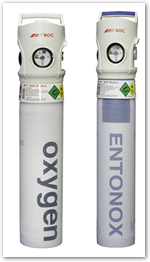Use of Portable Medical Oxygen/Entonox(Integral Valve) Cylinders
 The Health and Safety Authority (HSA) are issuing this revised Safety Alert in relation to the use of CD Portable Medical Oxygen Cylinders and ED Portable ENTONOX ® Cylinders, which are medicinal products incorporating a medical device as part of their closure system.
The Health and Safety Authority (HSA) are issuing this revised Safety Alert in relation to the use of CD Portable Medical Oxygen Cylinders and ED Portable ENTONOX ® Cylinders, which are medicinal products incorporating a medical device as part of their closure system.
Oxygen is non-flammable but strongly supports combustion (fire) and, under high pressure with certain conditions, can cause common materials to ignite suddenly (including some materials which do not normally burn in air). Oxygen at high pressure is highly dangerous and a fire can result when in contact with oils, greases, tarry substances and many plastics.
Portable Medical Oxygen and ENTONOX cylinders are utilised throughout and across all aspects of the healthcare system to provide a temporary uninterrupted portable oxygen supply to patients. They are further utilised in the home environment to enhance quality of life for oxygen dependent patients.
Operatives need to be mindful of the following potential occurrences and treat the Medical Oxygen and ENTONOX cylinders with due care and attention at all times.
Potential Occurrence 1
Although rare, when the valve of a Medical Oxygen cylinder is initially opened and a flow selected, an ignition within the cylinder valve can occur potentially leading to hot sparks being emitted.
- Ensure that a medical oxygen cylinder is set up and tested for use in a safe place away from the patient to prevent any adverse consequences should an ignition occur.
Potential Occurrence 2
When the valve of a Medical Oxygen or Entonox cylinder is initially opened, an uncontrolled release or escape of the gas can sometimes occur.
- Ensure that the medical oxygen and Entonox cylinder is set up and tested for use in a safe well-ventilated place where increased gas concentration levels are not a factor.
The following advice is provided by the HSA for guidance to enhance awareness and vigilance in the preparation and use of Portable Medical Oxygen and ENTONOX cylinders.
Important General Advice
Vigilance and attention by the operator during preparation / set up is of critical importance.
Oxygen / Entonox cylinders should be set up and prepared for use in a safe place away from the patient.
- Always follow manufacturers’ “Instructions for Use” to ensure safe preparation, set-up and safe therapy delivery.
- When setting up the cylinder, ensure there are no sources of ignition, combustible materials or anyone smoking in the vicinity.
- Never use oil or grease when using an oxygen cylinder or associated delivery equipment. Oils and greases can automatically ignite when in the presence of oxygen at high temperatures.
Preparation / Set up of the cylinder includes:
- Attaching the tubing to the cylinder;
- Opening the valve (slowly)
- Selecting a flow rate
During preparation/ set up - at all times observe for unusual noises or events and the potential occurrences outlined above. When opening the cylinder valve a click may be heard as the gas enters the valve. This will occur when the valve is operating normally.
Always open and close the cylinder valve slowly.
- Opening the valve quickly can cause the gas to become hot which may, in extreme conditions, lead to an external fire. Although Oxygen is non-flammable it will strongly support combustion once a fire has started.
During set up and testing the cylinder outlets should be facing away from the patient, bed and operator.
Ensure that the cylinder is functioning correctly before administering the gas to the patient.
Do not place the cylinder on the patient’s bed unless there is no alternative and never do so before set up and testing has been completed.
- Use extra care when there is no alternative to placing the cylinder on the bed, ensuring that the cylinder is functioning correctly.
Should any adverse event occur, the cylinder and associated attachments should be appropriately segregated and stored as per manufacturer’s instructions for examination.
- The event should be reported to the health service provider, the Health Products Regulatory Authority (HPRA) and the gas provider/ supplier.
- Should a dangerous occurrence arise the event should be reported to the Health and Safety Authority (HSA).
Training
Training in the safe use of Medical Oxygen / Entonox cylinders, particularly in relation to handling of cylinders and actions to be taken in the event of an uncontrolled gas release or fire, should be provided for all users.
Note
This advice is for guidance only; reference should also be made to the approved literature provided by the gas supplier. It is important that all personnel who operate or handle Oxygen / Entonox cylinders are aware of the manufacturer’s Instructions for Use (IFU), Summary of Product Characteristics (SPC) and Patient Information Leaflets (PIL) and other information in links below.
Medicinal product name and marketing authorisation number (PA)
- Medical Oxygen compressed Medical Oxygen Purity 99.5% min, PA0208/003/001.
- Entonox Compressed Medicinal gas (50% 02 / 50% Nitrous Oxide), PA0208/005/001.
Further Information
For Summary of Product Characteristics (SPC) and Patient Information Leaflets (PIL) visit:
http://www.hpra.ie/homepage/medicines/medicines-information
To report an adverse reaction or quality defect to the HPRA on www.hpra.ie click on “Patients and Public” and then “Report an Issue”
https://anaesthetists.org/Home/Resources-publications/Safety-alerts/Safety-initiatives/Safe-handling-of-oxygen-cylinders